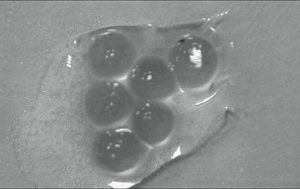
Long-term storage for immobilized microalgae
The entrapment, storage and processing of microalgae into alginate beads is a useful technology for stock culture management.
The biochemical characterization of wild female broodstock provides baseline data on the roles of lipids and vitamins in shrimp maturation.

The entrapment, storage and processing of microalgae into alginate beads is a useful technology for stock culture management.

Commercial black tiger shrimp hatcheries in India developed rapidly since 1993 due to drastic demand increases and seedstock shortages.

Greater Atlantic salmon feeding efficiency can be obtained through improved feeds and genetic selection for feed utilization.

Polyploidy in shrimp, or the application of triploid or tetraploid chromosomes, can result in superior culture performance.

Biosecurity in shrimp aquaculture is achieved by preventing the presence, growth, and spread of pathogenic microorganisms.

Chloramphenicol is an antibiotic banned for use in food animals by the European Union and the United States Food and Drug Administration.

Nutrient levels in Nile tilapia broodstock feed affect their frequency of spawning, clutch size, egg quality and overall seedstock output.

Several androgens have been used to direct the gonadal development of tilapia, with methyltestosterone the most commonly used.

A surge of new and familiar diseases in tilapia culture in Latin America is mainly related to the intensification of culture methods.

Tilapia were introduced to Central America during the 1950s by Taiwanese technicians working with the United Nations' FAO.

The GIFT program funded by the United Nations and the Asian Development Bank collected and tested Nile tilapia from the best strains worldwide.

Although tilapia genetics lag behind crop and livestock breeding, the pace of development may narrow the gap appreciably in coming years.

Some shrimp hatchery operators use live hermit crabs to feed black tiger shrimp broodstock because of a high proportion of omega-3 and omega-6 fatty acids.

Use of this method to detect and quantify IHHNV in penaeid shrimp has already revealed new information regarding levels of infection.

Shrimp farmers must consider seedstock quality, husbandry procedures and healthy nutrition as the primary tools to control disease.